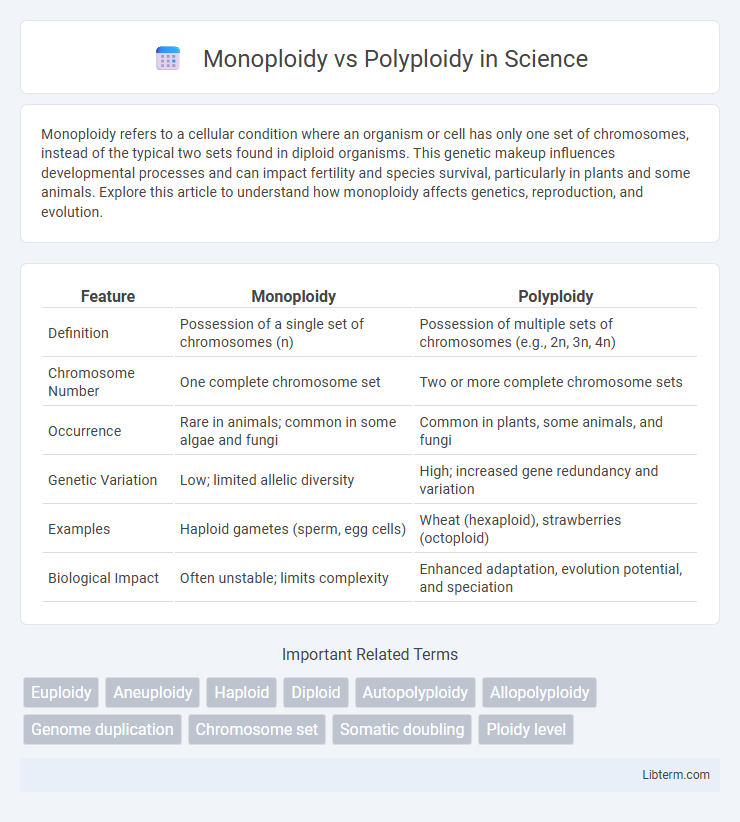Monoploidy refers to a cellular condition where an organism or cell has only one set of chromosomes, instead of the typical two sets found in diploid organisms. This genetic makeup influences developmental processes and can impact fertility and species survival, particularly in plants and some animals. Explore this article to understand how monoploidy affects genetics, reproduction, and evolution.
Table of Comparison
| Feature | Monoploidy | Polyploidy |
|---|---|---|
| Definition | Possession of a single set of chromosomes (n) | Possession of multiple sets of chromosomes (e.g., 2n, 3n, 4n) |
| Chromosome Number | One complete chromosome set | Two or more complete chromosome sets |
| Occurrence | Rare in animals; common in some algae and fungi | Common in plants, some animals, and fungi |
| Genetic Variation | Low; limited allelic diversity | High; increased gene redundancy and variation |
| Examples | Haploid gametes (sperm, egg cells) | Wheat (hexaploid), strawberries (octoploid) |
| Biological Impact | Often unstable; limits complexity | Enhanced adaptation, evolution potential, and speciation |
Introduction to Monoploidy and Polyploidy
Monoploidy refers to organisms or cells containing a single set of chromosomes (n), essential for studying genetic phenomena and haploid phases of life cycles. Polyploidy involves multiple sets of chromosomes (e.g., triploid 3n, tetraploid 4n), playing a crucial role in plant evolution, speciation, and agricultural improvement due to increased genetic variation. Both monoploidy and polyploidy influence genetic expression, fertility, and adaptation, making them fundamental topics in cytogenetics and breeding programs.
Defining Monoploidy: Characteristics and Examples
Monoploidy refers to the condition where an organism or cell contains a single set of unpaired chromosomes, denoted as n, in contrast to the typical diploid number of 2n found in most eukaryotes. Characteristics of monoploidy include reduced genetic variation and often developmental instability, which can affect viability and fertility, as seen in certain insect species like male bees (haplodiploidy system). Examples of monoploid organisms are rare but include gametophytes in plants and some haploid fungi, serving as crucial models for genetic studies and breeding programs.
Understanding Polyploidy: Types and Variations
Polyploidy refers to organisms possessing more than two sets of chromosomes, commonly seen in plants with types such as autopolyploidy, where chromosome sets originate from a single species, and allopolyploidy, resulting from hybridization between different species. Variations in polyploidy include triploidy, tetraploidy, hexaploidy, and higher levels, influencing traits like increased cell size, enhanced genetic diversity, and potential for speciation. Understanding these types and variations is crucial for applications in agriculture, horticulture, and evolutionary biology, where polyploidy contributes to crop improvement and adaptation.
Mechanisms Leading to Monoploidy
Monoploidy arises primarily through mechanisms such as the failure of chromosome duplication during cell division, resulting in cells with a single set of chromosomes instead of the typical diploid number. Processes like genome elimination, uniparental chromosome loss after fertilization, and errors during meiosis can generate monoploid cells. These mechanisms contrast with polyploidy, where complete chromosome sets are duplicated, leading to organisms with multiple sets of chromosomes.
Polyploidy Formation: Natural and Artificial Processes
Polyploidy formation occurs naturally through processes such as genome duplication during cell division errors or hybridization between different species, resulting in organisms with multiple sets of chromosomes. Artificial polyploidy is induced by chemical agents like colchicine, which disrupt spindle fiber formation, causing chromosome doubling in plants to enhance traits like size and resilience. This genetic modification plays a significant role in agriculture and horticulture by creating polyploid crops with improved yield, stress tolerance, and disease resistance.
Genetic Consequences of Monoploidy vs Polyploidy
Monoploidy results in a single set of chromosomes, leading to reduced genetic diversity and increased expression of deleterious recessive mutations due to the absence of homologous chromosome pairs. Polyploidy, characterized by multiple sets of chromosomes, enhances genetic variation and can mask deleterious alleles through gene redundancy, promoting greater adaptability and evolutionary potential. The disparity between monoploidy and polyploidy significantly impacts genomic stability, gene expression regulation, and the organism's capacity to tolerate genetic mutations.
Evolutionary Significance in Plants and Animals
Monoploidy, characterized by a single set of chromosomes, contributes to evolutionary adaptability by exposing recessive mutations and facilitating rapid selection in some plants and haplodiploid animals. Polyploidy, involving multiple chromosome sets, drives speciation and genetic diversity by promoting gene redundancy, novel gene functions, and increased heterozygosity, especially in plants like wheat and amphibians. This genomic complexity enhances environmental resilience, phenotypic variation, and adaptation, underpinning critical evolutionary processes across diverse taxa.
Monoploidy and Polyploidy in Agriculture and Breeding
Monoploidy in agriculture involves organisms with a single set of chromosomes, crucial for producing haploid plants used in breeding programs to rapidly achieve homozygosity and develop pure lines. Polyploidy, characterized by multiple sets of chromosomes, is widely exploited to enhance traits such as fruit size, vigor, and stress resistance in crops like wheat, strawberries, and bananas. Both monoploidy and polyploidy contribute significantly to plant breeding by enabling genetic manipulation and increasing genetic diversity, thereby improving crop yield and quality.
Advantages and Disadvantages: Monoploidy vs Polyploidy
Monoploidy, having a single set of chromosomes, allows for rapid genetic mutation expression, facilitating swift adaptation but often results in reduced viability and fertility due to lack of genetic redundancy. Polyploidy, characterized by multiple chromosome sets, enhances genetic diversity, increases cell size, and confers greater tolerance to environmental stress, though it may lead to challenges in meiosis and reduced fertility in some species. The advantages of polyploidy generally outweigh those of monoploidy in evolutionary fitness, with polyploid plants showing improved growth vigor and adaptability compared to typically fragile monoploid organisms.
Future Perspectives and Applications in Biotechnology
Monoploidy offers streamlined genetic manipulation in crop improvement, enabling faster trait fixation and more precise gene editing using CRISPR technology. Polyploidy enhances genetic diversity and stress resilience, making it invaluable for developing climate-smart crops with improved yield and disease resistance. Emerging biotechnological applications leverage synthetic polyploidy to create novel plant varieties with superior agronomic traits, accelerating sustainable agriculture advancements.
Monoploidy Infographic

 libterm.com
libterm.com